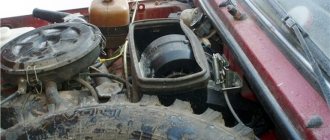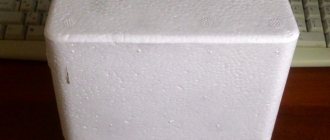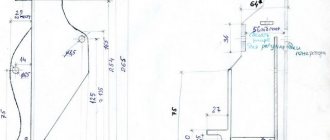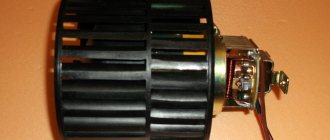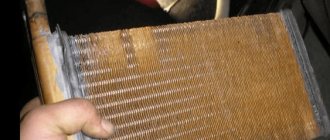- Revision instructions
- Connection diagram
- What did you improve?
It’s time to start heating the interior, otherwise in the cold weather the machine somehow stopped providing warmth, and the original fan was very noisy :( The idea of installing a fan from the eight was known for a long time, but never got around to bringing this matter to life. The first to This was decided by my friend Igor. He bought a Nyvka 213, and while it was standing in his garage, he decided to convert his heater. He dug himself, in the evenings. Then it was my turn.
So, a standard heater fan from a VAZ 2108 was purchased , the garage was cleared of snow and things began to boil. Since we did everything together, it was much more convenient to install and dismantle the stove.
To remove the top casing, simply unscrew the four bolts that hold it in place. Once the plastic is removed, you need to remove the cover blocking the air flow.
We thought about making some kind of option to leave the cover, but after much thought we came to the conclusion that it was not particularly needed :) To remove it, you need to unscrew the two nuts securing the bracket, and the cover itself can simply be broken off if it gets in the way :) Next, we take the rod and make markings on the plastic. Let me make a reservation right away: you need to move the fan a little to the side, otherwise the installation will be hampered by the hood lock. This point must be taken into account.
I recommend cutting out the plastic using a cutting machine. Very fast and convenient.
I think I would have to tinker with a nail file until I laughed :) The back wall would also have to be filed down, otherwise the fan simply wouldn’t fit in as needed. Now about the fan.
It is necessary to cut off all protruding parts of the fan mounting. Its body comes with several latches, which, to put it mildly, is not satisfactory. Therefore, before installation, we go over the joint with a soldering iron.
To attach the fan to the casing, we used strips of metal cut from the lining of old speakers. The result is a mesh that is easily and reliably fused into plastic using a soldering iron.
All joints are coated with a thermoplastic gun, and if there is none, then with sealant. In the lower part we make an additional partition made of plastic or duralumin to prevent air from escaping and water from entering directly into the stove radiator.
Everything is attached in the same way, plastic - with the help of metal strips, duralumin - with self-tapping screws. Then everything is coated with sealant.
After the main installation of the fan is completed, we install the casing with the fan in place, not forgetting to first draw out the wires. The earth is very conveniently attached to the fastening bolt, I don’t remember what???? see photo. Plus, accordingly, we take you to the salon.
So far, I have used a standard button as a rotation speed switch, but it is more convenient to install a switch from the same eight, coupled with resistance, since after a test drive it turned out that two speeds are clearly not enough.
And what hasn’t been done yet, but will need to, is to make plates on both sides of the fan to prevent direct contact with water. Made from duralumin, screwed on with self-tapping screws.
I did not remove the lower part of the stove, where the fan was located, because IMHO it does not particularly interfere and it will then be more convenient to attach corrugations to it for supplying heating to the legs. So far, only the holes for air flow to the legs have been cut, and the damper itself for supplying air to the legs is screwed on and sealed with sealant.
Along the way, the regulator for supplying coolant to the heater along with the cable was rebuilt and lubricated, the air duct was cleaned and sealed, and all debris was removed from the heater. The result exceeded all expectations. The first thing that struck me was how quiet it was! At first speed, only air noise is audible. Secondly, it began to really blow, and not that pitiful semblance of air flow that was in the standard stove.
And of course, general satisfaction from the work done :) Good luck to everyone!
Do-it-yourself car lift for the garage
- Winter is on the street. It’s cold... The stove fan died... everyone came...
- BUT: 1) the figure-eight snail was purchased a long time ago and is waiting in the wings; 2) there is a desire and time to modernize the heater...
- SO, having read the forums on installing the figure-eight snail, I do as the great gurus of the forum suggest: installing a fan like Sad Sam and Igor, Sam and other respected forum participants (sorry, I didn’t mention who); The switch was set to eight (now three speeds), the drive of the lower heater panel was made like Trener, for which a special thank you and deep bow to him.
RESULT: the engine is cold - the airflow is wonderful! the engine has warmed up - the airflow is wonderful, BUT WHERE IS THE WARMTH? It became noticeably colder. So, after traveling for two days (there was no free time), I began to figure out what was what.
DANCING WITH A TAMBORO: Having removed the lower heater casing (which is behind the beard), I find out that the radiator (and I have a standard aluminum radiator) is blown through at high speed, and the air simply does not have time to warm up! In this case, the effectively used radiator area does not exceed 30% (!).
Conclusion: I messed up when installing the fan in the boot - part of the fan output nozzle is blocked by the radiator casing and, on top of that, there is practically no air flow distribution because
the distance to the radiator is 54 mm maximum... After thinking a little, I implemented two intermediate options with air flow distributions... Each time it became much better! (but that’s not enough for me, I’m a gardener)… Then, after consulting with a friend (Zhenya, thank you), I removed all the installation dimensions…
- Having removed everything unnecessary in front of the radiator, together with my brother-in-law (Rustam, thank you) by selecting the angles of the plates, we made this thing:
- I collected it the next day alone:
Then the test - I removed the lower heater casing (which is behind the beard), turned on the fan... The distribution of the air flow from the fan is at the “good” level, the effectively used radiator area is within 90% (however, there are minor dips in the air flow pressure, the hand can barely tolerate it.
That's it, I'll calm down on this.
OPERATION: it’s -20 o outside in the morning, I start the engine. It takes a long time to warm up (but that’s another story), at 50 o the windshield quickly came off, and by the time I got to work the car became more than warm. And now I don’t need the copper, three-row radiator, which I almost bought!
Modernization of the stove at NIVA (installation of a “snail” from 2108)
The stove in Niva is frankly bad! One of its most important problems is the fan itself, which often makes squealing sounds and its performance is quite low...
The main reason for the unpleasant sounds of the fan is the fact that it is installed under the radiator, and even in a vertical position.
Passing through it, the already heated air greatly heats the fan motor itself and all the lubricant gradually drains from the rotor.
As a result, the motor begins to squeal, since over time the bushings remain almost without lubrication. I think many are familiar with this problem!
But the problem is solvable! We install the “snail” from the VAZ-2108 and get increased productivity, silence, and, if desired, three control speeds.
The idea itself is generally not new; I also borrowed it from one of the forums. Only everyone does it in their own way. Here's how I did it...
- One of the main advantages after the conversion is that you can’t hear the stove motor at all, since the motor itself is now located in the engine compartment!
- So, the process: Remove the heater from the car and disassemble it...
If you want to have three speeds, we embed a heater resistor from a VAZ-2108/M2141 into the lower part of the body, on the driver’s side.
We glue all the joints of the case, and especially the place where the radiator is installed, with a rubber seal (you can buy it at any hardware store)
Assembling the lower part. We don’t put the fan itself there, we just throw it away, we don’t need it anymore!
We disassemble the upper part of the heater, remove the grille from the air intake...
And carefully, with minimal gaps, we cut out a place for the “snail” from the VAZ-2108. We install it as shown in the photo below (inside view)
We also carefully fill the remaining cavity with polyurethane foam, sealing all “unnecessary” places with masking tape to avoid gluing the fan itself! Then, after hardening, we cut it flush with the bottom of the air intake housing.
This is what the final air intake should look like:
We put a seal on it and install it under the hood in its place...
As you can see, it doesn’t take much effort and the result is worth it! Productivity increases significantly and the interior warms up faster.
Auto installations: Arthur Tevs (aka Fast)
Source: https://autoclub.tomsk.ru/?p=653
What did you improve?
The modernized stove has a number of advantages:
- Quiet, and at 1st speed silent.
- Productive, at speed 1 it blows at the level of speed 2 of the old fan. At maximum speed, dust will fly out of the air ducts.
Such tuning of the heating system is mandatory for drivers of northern cities.
Where can I buy
: in our online store (category Lada 4×4 stove).
Have you improved the Lada 4×4 stove in this way? Write reviews and additions on this modernization, take part in the survey. Let us remind you that other modifications to the SUV are published in this category.
Photo: Flea in-flight magazine
Keywords: stove 4x4 | 4x4 air ducts
0 0 2 0 0 0
Share on social networks:
Heater snail from 2108 on Niva 2121, VAZ 2131
Do-it-yourself tuning of the Niva 2121 interior, tips for modifying the interior, internal tuning of the Niva 2131, VAZ 2121. Tuning VAZ cars is an increase in the factory characteristics of the car. Refinement of the Niva 2121 is, first of all, the installation of new bumpers, crankcase protection, and a winch.
If desired, the owners of these SUVs install additional fog lights. Our sections describe instructions and tips for modifying the Niva 2131 of various units, such as the transfer case, etc. Even a car enthusiast can do complex tuning of vases with his own hands.
You will also find categories for engine tuning, gearbox tuning, interior and exterior tuning, as well as many photo reports of VAZ 2121 tuning. Thanks to interesting solutions, Niva tuning will give you a lot of pleasure and benefits.
If you have photos of tuning vases, send them to us by email.
The stove in Niva is frankly bad! One of its most important problems is the fan itself, which is installed under the radiator, and also vertically. Hot air passing through it heats it up greatly and all the lubricant gradually drains from the rotor.
As a result, the motor starts to squeal! Probably everyone knows this problem! Well, productivity there is generally zero... The problem is solvable! We install the “snail” from the VAZ-2108 and get increased productivity, silence, and, if desired, three control speeds. The idea is not new, I borrowed it from other sites.
But everyone does it in their own way - this is how I did it...
- With all this, after remaking the stove motor, you can’t hear the stove at all, since the motor itself is now located in the engine compartment!
- We completely disassemble the entire heater!
If you want to have three speeds, we embed a heater resistor from a VAZ-2108/M2141 into the lower part of the body, on the driver’s side.
We glue all the joints of the body, and especially the installation location of the VAZ 2121 radiator, with a rubber seal (available in any hardware store)
We assemble the lower part, the VAZ 2131 engine with the fan is simply thrown out from there! We don't need him anymore!
We disassemble the upper part of the heater, remove the grille from the air intake of the Niva 2121...
And carefully, with minimal gaps, we cut out a place for the “snail” from the VAZ-2108. We install it as shown in the photo (bottom view)
We fill the remaining cavity with polyurethane foam! Then, after hardening, we cut it flush with the bottom of the air intake housing.
This is what the Niva 2131 air intake should look like!
We put on the seal and install it under the hood!
Source: https://vazclub.com/niva/2121-2131/tyuning/salona/ustanovka-novoi-ulitki-otopitelya.html
Improvement No. 1. We take air from the cabin
The main disadvantage of the Niva heater is that all the air into the heater radiator comes from the street, and when the air intake flap is closed, air circulation and heating stop completely. To eliminate this drawback, I disassembled the heater (I had to drain some of the antifreeze and disconnect the heater radiator pipes), and in the side wall of the heater housing, opposite the wall where the radiator tubes exit, I made a hole in the shape of a rectangular trapezoid. I did it in such a way that there was 1.5-2 mm of the body wall left to the boundaries of the plane in which I made the hole, and 6-8 mm from the side of the stiffener for attaching the petal valve. I made the hole using a drill, marked it, drilled along the contour of the small diameter holes, then connected the holes using a knife, then filed the edges of the resulting hole, giving it its final shape. The area of the resulting hole was approximately 25 square centimeters. It is through this hole, when the heater air intake flap is closed, that air is drawn from the passenger compartment.
Since the salon is a closed space, air circulation occurs in a closed circle, and the warming up air of the salon, passing through the heater radiator, becomes increasingly hotter at the exit. Despite the small size of the hole, due to the absence of a supply of icy air from the street, the time for warming up the interior to a comfortable temperature and melting icy glass is reduced by 4-5 times, and it is possible to achieve a comfortable temperature even in severe frost.
To prevent cold air from entering the cabin through the hole when the air intake flap is open and the heater fan is turned off, a petal valve is installed on the hole on the inside of the heater housing, which does not interfere with air intake from the cabin. The petal valve is a rubber band cut from a car chamber (preferably from a truck), 1.5-3 mm thick, in the shape of a hole, but slightly larger, and attached to a bolt in such a way that it can freely bend inside the heater body, opening the access of air from interior, and fit snugly against the wall of the heater housing, blocking the hole for the passage of cold air into the cabin, past the heater radiator.
How to remodel the stove on Niva 21213 with your own hands?
Do-it-yourself modification of the stove on Niva 21213 is necessary if the car’s heating system malfunctions. There is no point in delaying this, because uneven thermal regulation leads to foggy windows or icing. In any of these cases, the view of what is happening on the road deteriorates. The malfunction causes wear of individual elements of the device or manufacturing defects.
Fault Diagnosis
The stove supplied as standard will need to be modified for preventive purposes. The procedure will not take much time, but it will prevent many problems in the future. Driving experience suggests that the first severe frosts will undermine the “health” of the device. The list of main weaknesses is as follows:
- the optimal operating temperature range for model 2121 is from -5 to +10°C;
- inability to warm up the air in the cabin if outside is -8°C or lower;
- when the blowing power increases, the temperature does not increase;
- When driving in 2nd gear, the noise from the Niva's stove becomes significant.
That is why it is better to take the necessary measures in advance. The driver has few alternatives. On the one hand, everything remains in its place. The heating device is used at minimum power. During mild winters this is still tolerable, but with the onset of real cold weather the conditions will become unbearable. On the other hand, it's easy to spend a few hours rectifying the situation.
Further developments proceed as follows. If the heating in the car is running at ½ power, you can limit yourself to minor repairs. The main thing is to make sure that there are no noises or extraneous knocks, otherwise the Niva 21213 should immediately go for a technical inspection.
The presence of an unpleasant sound indicates the need to replace the device. A specialized retail network offers ready-made options for heating mechanisms for Niva. If desired, it can be assembled independently.
Technical details of the procedure
The efficiency of the new heating system on Niva will be determined not by the cost of the purchased parts, but by their quality. To operate, you will need the following elements: a car resistor, a figure-eight heater and a “snail”. It is a mistake to believe that only “original” spare parts are suitable for repairing a heating device. The main requirement is technical compatibility.
If in doubt, a drawing of the heating system will provide clarity. The further procedure is as follows:
- Cut a new mounting hole. This is done carefully, because the reliability of the heating system’s operation depends on the quality of the preparatory process. It is recommended to place the engine as low as possible in the air duct, otherwise the device will rest against the hood. This should not be allowed to happen, otherwise the stove fan will not last long.
The heating system of a new model is checked by test switching on. It is recommended to switch modes smoothly. The device must remain on each of them for at least 5-7 minutes. The driver’s task is to make sure that the operation of the system is not accompanied by extraneous noise and vibration.
Original parts vs analogues: practical advice
As mentioned earlier, such a choice does not affect the quality of the heating system. At the same time, car mechanics make several reservations. For those who plan to use VAZ stoves, it would be useful to check the power system. It is different for some modifications. That is why all actions are consistent with the drawings.
It is permissible to use the VAZ 2108 heater, provided that two recommendations are followed. Firstly, the mounting socket is 1-2 cm larger than the size of the device. The additional area will reduce the vibration impact. Secondly, the switch is installed taking into account the specifics of the VAZ heating system. You will have to tinker less when minor modifications to the system are needed.
The ventilation system is updated in 1-2 hours, depending on the degree of wear of the engine.
If the factory-installed “snail” has no signs of physical wear, you only need to replace the heater “engine” itself.
It’s worse if the factory equipment of a Chevrolet model has manufacturing defects. A complete replacement of the device is recommended. This will save time.
The operation of the heating system determines the comfort and safety of driving. The driver constantly monitors the system's performance. If extraneous noise appears, it is necessary to urgently carry out a technical inspection.
Improvement No. 2. Increasing fan performance
I also slightly increased the efficiency of the standard heater fan. The fact is that the gap between the fan blades and the diffuser is about 3 mm, and the width of the diffuser is no more than 15 mm, while the width of the fan blades is more than 30 mm. Therefore, some of the air leaks back between the blades and the diffuser, preventing a large pressure difference from being created between the suction area and the discharge area.
According to my estimates, the efficiency of the fan increases by 10-15%, so you don’t have to bother with this problem.
Replacing the faucet
How to install an additional stove on a gazelle
There is one more element in the design of the Niva’s heating system that significantly reduces its performance. This is the stove faucet. It has a small cross-section, which in turn significantly slows down the circulation of antifreeze in the system, which is why the stove needs more time to warm up. Replacing this faucet will help improve the situation. The best option is to install this element from a foreign-made car. Heater taps from some Opel or Volkswagen models have proven themselves well.
The faucet is replaced as follows:
- It is necessary to open the hood and get close to the heater hose in the engine compartment, then loosen its clamp and remove the hose from the pipe.
- We unscrew the screws that secure the seal to the plane of the partition.
- Remove the sealant layer by first prying it off with a screwdriver.
- The glove compartment is removed.
- It is necessary to loosen the screw that secures the faucet by approaching it from the interior.
- There is a control cable on the crane lever; it must be removed.
- Depending on the design of the Niva-21213 stove, its body can be secured with two nuts or two screws.
- The new heater tap is installed on the car in the reverse order.
We emphasize that in the case of a screw fastening of the stove faucet to the heat exchanger, this procedure is somewhat problematic, since the nuts constantly fall out. To do this, they simply need to be secured with plasticine or chewing gum. In addition, it is worth adjusting in advance the cable that controls the position of the heater tap. If this is neglected, then during the operation of the stove you will have to constantly climb under the dashboard in order to set its position.
Replacing the faucet
Replacing the heater radiator on a Chevrolet Niva
Heater design flaws are not limited to poorly made fans, as well as the design of air ducts. Even the stove faucet does its job poorly. Its cross section is small. Therefore, the movement of coolant through the heater radiator occurs rather slowly. To improve the operation of the stove as a whole, it is necessary to replace the tap.
It is best to take the heater valve from foreign cars. They last longer, and their performance is high. Cranes from budget Volkswagens, as well as some Opels, are suitable. This allows you to minimize the work of fitting parts. Replacement is carried out in the following order:
Under the hood, using pliers, loosen the clamp securing the hose to the pipe. The hose is removed, it is better to do this with gloves. The hose “sits” quite tightly on the nozzle; when removing it, your hand may fall off; the glove will protect you from damage; Using a spanner “7” we unscrew the screws securing the seal to the partition; The seal is pryed up with a screwdriver and removed; The storage shelf is removed; From inside, use an open-end wrench to loosen the crane clamping screw; The cable is removed from the crane lever; Depending on the modification of the stove radiator, the tap can be secured with either 2 screws or 2 nuts. They should be unscrewed; We remove the tap from the car; We remove the pipe from it, it is secured with 2 nuts.
Technical details of the procedure
The efficiency of the new heating system on Niva will be determined not by the cost of the purchased parts, but by their quality. To operate, you will need the following elements: a car resistor, a figure-eight heater and a “snail”. It is a mistake to believe that only “original” spare parts are suitable for repairing a heating device. The main requirement is technical compatibility.
If in doubt, a drawing of the heating system will provide clarity. The further procedure is as follows:
- Cut a new mounting hole. This is done carefully, because the reliability of the heating system’s operation depends on the quality of the preparatory process. It is recommended to place the engine as low as possible in the air duct, otherwise the device will rest against the hood. This should not be allowed to happen, otherwise the stove fan will not last long.
The heating system of a new model is checked by test switching on. It is recommended to switch modes smoothly. The device must remain on each of them for at least 5-7 minutes. The driver’s task is to make sure that the operation of the system is not accompanied by extraneous noise and vibration.
